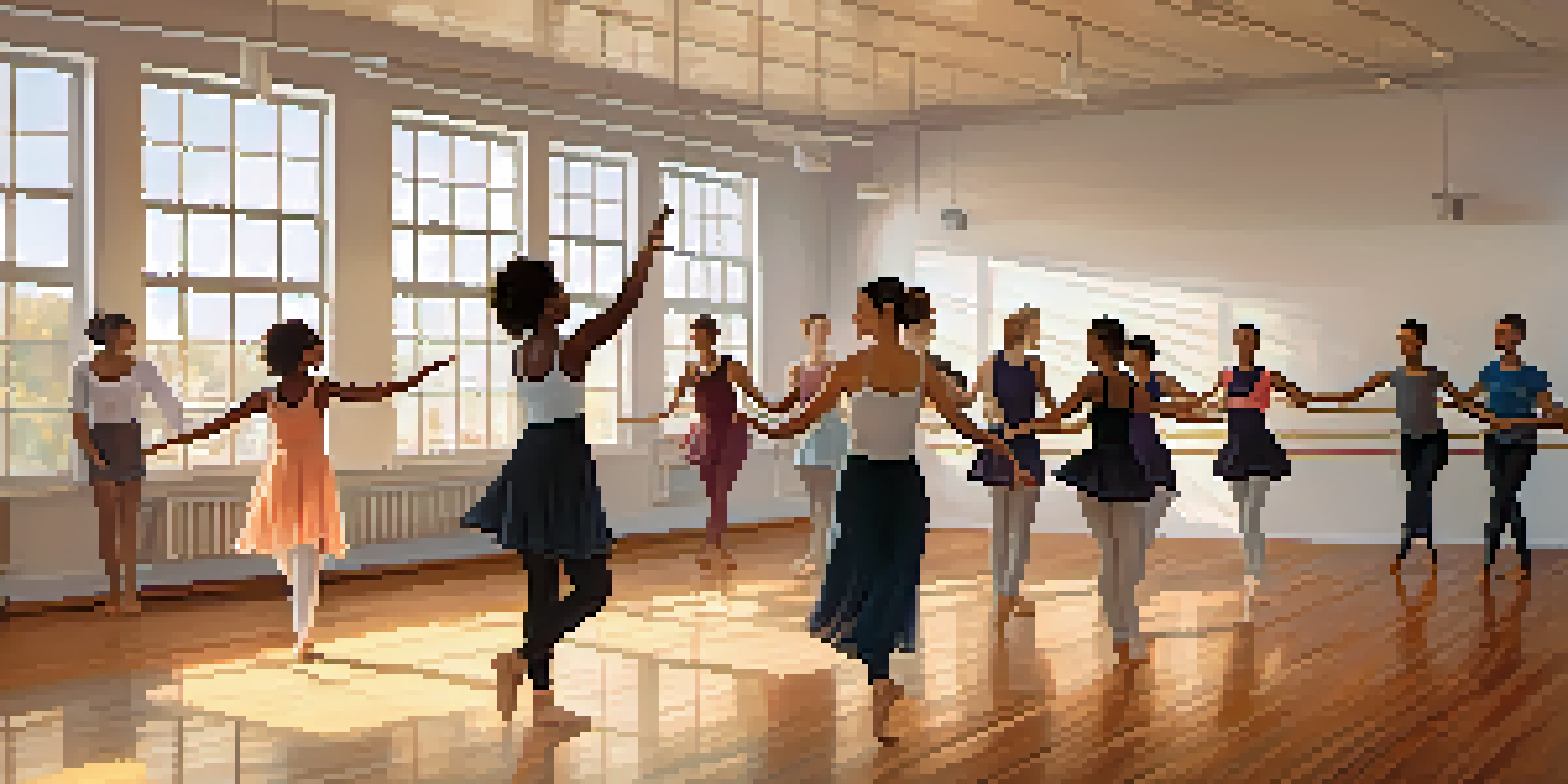Embodied Healing: The Role of Dance in Mental Health

Understanding Embodied Healing and Its Importance
Embodied healing refers to the practice of using the body as a medium for emotional and psychological healing. It recognizes that our mental state is deeply connected to our physical sensations and movements. By engaging in practices that promote awareness of the body, we can facilitate emotional release and mental clarity.
Dance is the hidden language of the soul.
This approach emphasizes the importance of physicality in mental health, suggesting that movement can help us process feelings that are often difficult to articulate. For many, the body holds onto stress, trauma, or unresolved emotions, making it essential to find a way to express and release these feelings. Dance becomes a powerful tool in this context, allowing for a safe and creative outlet for emotions.
Engaging in movement can lead to a state of flow, where individuals feel more connected to themselves and the world around them. This state not only promotes relaxation but also enhances self-awareness, ultimately contributing to improved mental health. The beauty of embodied healing is that it makes the often abstract concept of mental wellness tangible and accessible.
The Therapeutic Benefits of Dance in Mental Health
Dance therapy, a form of embodied healing, has been shown to reduce symptoms of anxiety, depression, and PTSD. By allowing individuals to express themselves through movement, dance therapy helps release pent-up emotions that may be contributing to mental distress. This creative expression fosters a sense of freedom and joy, which can be transformative for many.

Research has demonstrated that participating in dance can lead to increased levels of serotonin, the ‘feel-good’ hormone, which plays a crucial role in regulating mood. Additionally, the rhythmic nature of dance promotes relaxation and mindfulness, further enhancing its therapeutic benefits. When individuals engage fully in dance, they often find a sense of liberation and empowerment, which can significantly boost their mental health.
Embodied Healing Enhances Wellness
Engaging in practices like dance helps individuals connect their physical sensations with emotional release, promoting mental clarity.
Moreover, dance creates a unique sense of community and connection. Whether through group classes or performances, individuals can forge supportive relationships that help combat feelings of isolation, a common issue in mental health struggles. This social aspect adds another layer of healing, making dance not just a solitary practice but a shared experience.
How Dance Can Foster Emotional Expression
One of the most profound aspects of dance is its ability to express emotions that are often difficult to put into words. Each movement can symbolize feelings of joy, sadness, anger, or love, allowing individuals to communicate their inner experiences without needing to speak. This non-verbal expression can be particularly beneficial for those who find it challenging to articulate their feelings verbally.
The body says what words cannot.
For instance, someone experiencing grief may find solace in free-form dance, allowing their body to move in a way that mirrors their emotional state. This process can serve as a cathartic release, helping them to process and move through their grief. Similarly, joyful moments can be celebrated through dance, reinforcing positive emotions and creating a sense of connection to others.
By creating a safe space for emotional expression, dance encourages individuals to explore their feelings more deeply. This exploration can lead to increased self-acceptance and understanding, essential components of mental well-being. In essence, dance becomes a language of its own, one that speaks directly to the heart and soul.
Building Body Awareness Through Dance
Body awareness is a critical element of mental health, and dance plays a significant role in cultivating it. When individuals dance, they become more attuned to their bodies, noticing how different movements feel and how their emotions manifest physically. This heightened awareness can lead to better self-regulation and a deeper understanding of one’s emotional responses.
For example, someone might discover that certain movements release tension in their shoulders, a common area where stress is held. Recognizing this connection can empower individuals to incorporate movement into their daily routines as a way to manage stress and anxiety. Over time, this practice fosters a stronger mind-body connection, enhancing overall well-being.
Dance Therapy Reduces Mental Distress
Dance therapy effectively alleviates symptoms of anxiety, depression, and PTSD by fostering emotional expression through movement.
As participants grow in their body awareness, they often find it easier to identify their emotional states and respond to them constructively. This journey of self-discovery through dance not only enhances mental resilience but also encourages a greater appreciation for the body’s capabilities. Ultimately, it reinforces the idea that nurturing the body is an integral part of maintaining mental health.
Creating a Safe Space for Healing Through Dance
Creating a safe and supportive environment is crucial for effective embodied healing through dance. In group classes or therapy settings, the atmosphere should be one of acceptance and non-judgment, allowing individuals to explore their movements freely. When participants feel safe, they are more likely to engage fully and express their emotions authentically.
This safe space encourages vulnerability, which is essential for healing. Participants can share their experiences, learn from one another, and support each other in their journeys. Whether in a structured dance therapy session or an informal gathering, the sense of community can amplify the healing effects of dance.
Moreover, instructors or therapists play a vital role in fostering this environment. Their guidance and encouragement can help individuals feel more comfortable taking risks with their movement and expression. By prioritizing safety and support, we can unlock the full potential of dance as a transformative tool for mental health.
Incorporating Dance Into Daily Life for Mental Wellness
Incorporating dance into daily routines doesn’t have to be complicated or time-consuming. Simple practices like putting on your favorite music and moving freely in your living room can offer significant mental health benefits. These moments of spontaneous dance allow individuals to break free from the day’s stresses and reconnect with their bodies.
Additionally, many people find joy in joining community dance classes or online dance workouts, providing both structure and social interaction. These classes often promote physical fitness while also serving as an outlet for emotional expression. The key is to find a style of dance that resonates personally, whether it’s ballet, hip-hop, or even Zumba.
Creating Safe Spaces for Expression
A supportive environment in dance allows individuals to explore emotions freely, enhancing the healing process through community connection.
Over time, making dance a regular part of your life can lead to heightened feelings of joy and reduced stress. The more you engage in dance, the more you’ll likely notice its positive effects on your mental health. It becomes a joyful ritual, a way to celebrate life and express emotions, reinforcing the connection between body and mind.
Conclusion: Dance as a Path to Mental Healing
In conclusion, dance serves as a powerful medium for embodied healing, promoting mental health and emotional expression. Through movement, individuals can access and release emotions that may otherwise remain unspoken, creating a pathway toward healing and self-discovery. The therapeutic benefits of dance are well-documented, showcasing its ability to reduce anxiety, depression, and stress.
As we’ve explored, dance fosters body awareness, builds community, and creates a safe space for emotional exploration. It encourages individuals to embrace their physicality and connect deeply with their feelings, leading to enhanced mental resilience. With its joyful and expressive nature, dance offers a unique approach to nurturing mental health.

So whether you’re taking a dance class, moving to your favorite tunes at home, or simply appreciating the art of dance, remember that it’s not just about the steps—it’s about the healing journey that unfolds with each movement. Embrace the rhythm of life, and let dance be your guide to mental wellness.